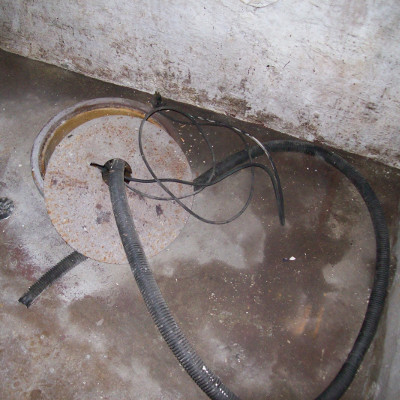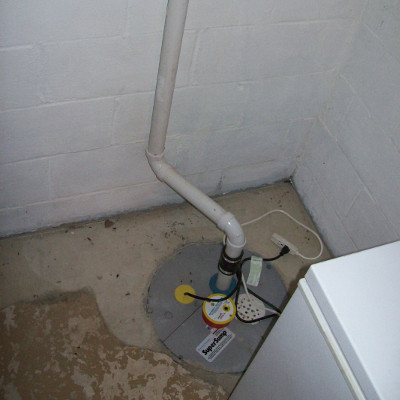About Inflow and Infiltration (I/I)
The sanitary sewer system is designed to convey domestic and commercial wastewater to the wastewater treatment plant, where pollutants and wastes are removed before the water is discharged to the environment. Rain water and ground water, often called 'clear water', typically do not need to be treated. Clear water should discharge to the ground surface or storm sewer and flow into receiving streams and lakes, and should not be discharged into the sanitary sewer.
Excess clear water in the sanitary sewer collection system leads to high flows, which can result in basement sewage backups and untreated wastewater being discharged into receiving streams. It can also result in increased taxpayer costs to construct and maintain a larger-than-necessary collection system.
The City performs regular maintenance to help correct cracks and defects in pipes and manholes to reduce clear water entering into the sanitary sewer collection system. However, a major source of clear water often comes from private properties, which is collected through roof drains, sump pumps, seepage collection systems ("beaver drains") and footing drains.
A few sump pumps or footing drains that are improperly connected to the sanitary sewer can significantly impact a community's collection system. A typical sanitary sewer pipe in a residential neighborhood is 8 inches in diameter, with a typical capacity of 350 gallons per minute (gpm). This capacity is sufficient if only domestic wastewater enters the pipe. However, if a few sump pumps discharge between 20 - 100 gpm each, the pipe can quickly become overloaded, potentially leading to backups in that neighborhood.
The City of Algona will conduct sanitary sewer connection inspections to verify that footing drains, sump pumps, roof drains, and other clear water sources are not connected to the sanitary sewer system.
The goal of this program is to remove clear water from the sanitary sewer collection system, to help reduce the potential for sanitary sewer backups, leading to improved public health, extended service life of the sanitary sewer collection system and treatment plant, and lowering costs for taxpayers.
Additional I/I Handouts and Information
- Metropolitan Council Website - Reduce Inflow and Infiltration (I/I)
- Handout - Additional I/I information
- For more information go to the Notice page
About the Inspections
Timeframe: The program area will be inspected from fall of 2024 through spring of 2025. The City will be divided into sectors, each designated by a color to stagger inspection times throughout this period. Inspections in the Red Sector were prioritized in fall of 2024. Spring of 2025 will prioritize inspections in the Yellow Sector, then Blue, then Green. MAP
Scheduled Appointments: To ensure resident safety, all inspections will be scheduled. No door-to-door inspections will be conducted. Inspections will typically take place between the hours of 7:30 am and 6:00 pm.
Web or Telephone Scheduling: Both a telephone number and a web-based option are available for easy appointment scheduling. The secure web-based scheduling system allows residents to schedule their appointment online, while those who prefer not to use the internet can call our toll free telephone number to schedule.
Identification of Inspectors: WHKS inspectors will wear identification badges with both WHKS and City logos, as well as WHKS-branded clothing and vehicles. If you have any questions about the identity of an inspector, please feel free to contact us.
Prepare for the Inspection: Before the inspection make sure there is clear and easy access to your sump pump (if applicable) and the water meter (for material inventory). This will allow the inspection to occur in a timely matter.
The Inspection: An adult occupant must be present during the inspection. There are two types of inspections for each property: a sump inspection and a lateral inspection.
The sump inspection will involve observing the following items:
- Exterior Grading: Does the exterior grading slope toward the building?
- Roof Drains: Are roof drain downspouts directed to the ground?
- Basement: Is there a basement?
- Seepage Collection System (Beaver System): Is there a seepage collection system? If so, does it discharge into a sump pit (proper) or the floor drain (improper)?
- Sump Pit/Sump Pump: Is there a sump pump? If so, does it discharge outside the basement through a rigid pipe (proper), a floor drain (improper), or either location through a flexible hose (improper)?
- Pipe Information: What is the size and material of the service lateral?
- Observations: Are there any roots, mineral deposits, cracked pipes, offset joints, or sags in the service lateral?
- Foundation Drains: Is there a footing drain connection? If so, where is the footing drain?
If an improper connection is found, the inspector will issue a Violation Notice to the occupant and explain the necessary steps and timeframe for correction. A reinspection must be scheduled to verify that the correction has been made.
Inspection Time: A typical inspection can be completed in under 30 minutes.
| Improper connection: Flexible Hose | Proper connection: Rigid Discharge Pipe To Exterior. |
 |
 |
Improper Connection Footing Drain